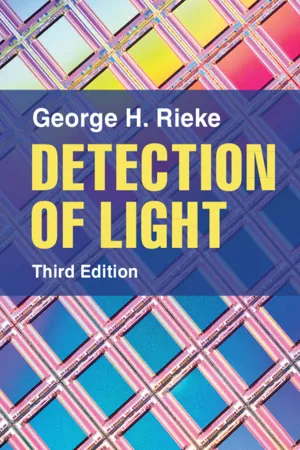Detection of Light
About this book
The invention and development of advanced methods to detect light underlies much of modern technology. This fully updated and restructured third edition is unique amongst the literature, providing a comprehensive, uniform discussion of a broad range of detection approaches. The material is accessible to a broad range of readers rather than just highly trained specialists, beginning with first principles and developing the relevant physics as it goes. The book emphasizes physical understanding of detector operation, without being a catalog of current examples. It is self-contained but also provides a bridge to more specialized works on specific approaches; each chapter points readers toward the relevant literature. This will provide a broad and lasting understanding of the methods for detecting light that underpin so much of our technology. The book is suitable for advanced undergraduate and graduate students, and will provide a valuable reference for professionals across physics and engineering disciplines.
Frequently asked questions
- Essential is ideal for learners and professionals who enjoy exploring a wide range of subjects. Access the Essential Library with 800,000+ trusted titles and best-sellers across business, personal growth, and the humanities. Includes unlimited reading time and Standard Read Aloud voice.
- Complete: Perfect for advanced learners and researchers needing full, unrestricted access. Unlock 1.4M+ books across hundreds of subjects, including academic and specialized titles. The Complete Plan also includes advanced features like Premium Read Aloud and Research Assistant.
Please note we cannot support devices running on iOS 13 and Android 7 or earlier. Learn more about using the app.
Information
Table of contents
- Cover
- Half-title
- Title page
- Copyright information
- Contents
- Preface
- 1 Introduction
- 2 Photodetector Basics
- 3 Infrared (and Optical) Photodetectors
- 4 Amplifiers, Readouts, and Arrays
- 5 Charge Coupled Devices
- 6 Other Photodetectors
- 7 Superconducting Detectors
- 8 Bolometers
- 9 Visible and Infrared Coherent Receivers
- 10 Submillimeter- and Millimeter-Wave Heterodyne Receivers
- Appendix A Useful Constants and Conversions
- Appendix B Answers to Selected Problems
- References
- Index
